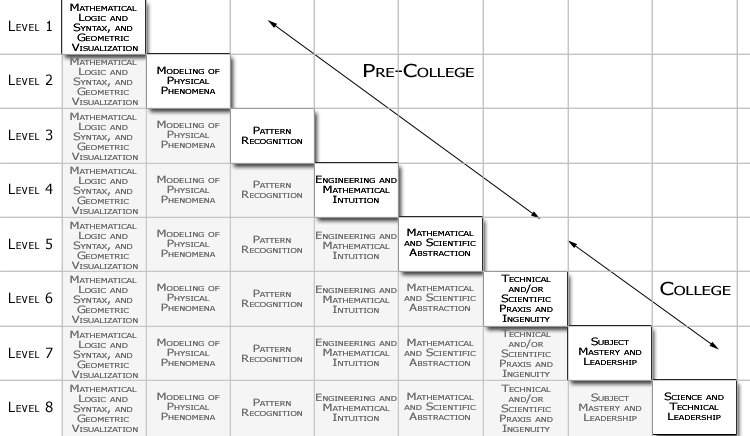Guiding
Principle
In science, technology, medicine, economics and society, as well
as other areas of human endeavors, we are constantly faced with intricate
and complex problems that surpass our capabilities and capacities
to address them. The creation of strategic human capital, capable
of successfully addressing these types of problems, is an ever-present
challenge to humanity.
For the past ten years, CAHSEE has sought ways to successfully develop
strategic human capital, drawing from primarily underprivileged segments
of our society. We are guided by the belief that children are capable
of achieving excellence if properly stimulated, guided and challenged
from an early age.
to top
Human
Capital Development Paradigm
Math, science and engineering education provides an enabling environment
for the development of the intellectual abilities and academic capacities
that, coupled with an attitude of civic responsibility and professional
conduct, foster the creation of strategic human capital.
CAHSEE's human capital development paradigm centers on the cultivation
of the intellectual abilities, academic capacities, professional conduct
and civic responsibility for the preparation of scientific, technical,
professional and civic cadre of the highest order
- Intellectual abilities
- Visualization of complex structures
- Conceptualization of abstract phenomena
- Pattern recognition in math and science
- Mathematical and engineering intuition
- Mathematical and scientific abstraction
- Academic capacities
- Mathematical syntax and grammar
- Modeling of natural and economic phenomena
- Analysis and synthesis as the fundamental method
of abstraction
- Academic discipline
- Subject mastery
- Independent learning
- Professional conduct
- Commitment to excellence
- Competitiveness
- Precise and clear communication skills
- Teamwork and team leadership
- Risk-taking
- Strategic and tactical thinking
- Planning, execution, follow-up, control and evaluation
- Civic responsibility
- Conduct according to the honor code
- Concern for others
Based on this paradigm, CAHSEE emphasizes the achievement of the
aforementioned qualities in its educational strategies. Learning to
capture the essence of a problem is more important than learning topics
and following curricula mechanically. Thus CAHSEE's programs are content-based
and not curriculum-based.
to top
Structure
of CAHSEE's Human Capital Development Paradigm
To materialize the aforementioned qualities, CAHSEE has designed
a system of interlocked levels that foster the development of multiple
aspects of the paradigm.
- Level One (Mostly 5th and 6th,
some 7th graders): Introduction to the rigors of mathematical
topology and geometrical visualization of complex structures. The
purpose is to develop the student's capacity to understand mathematical
logic and syntax, and to manipulate graphical geometrical constructs.
- Level Two (6th, 7th and 8th graders):
Conceptualization and modeling of physical and economic phenomena
with a strong emphasis on the theoretical foundations and constructs,
and physical laws, that serve as the basis for scientific modeling,
and economic principles. Students are introduced to problem solving
in science and engineering economy.
- Level Three (8th. and 9th graders):
Pattern recognition focuses on teaching students the logic and inner
structure of patters and decomposing and manipulating for problem-solving.
- Level Four (Mostly 10th graders):
Introduction to engineering and mathematical intuition. Emphasis
is placed on the student's capacity to understand conceptual complexities
and develop an intuition for problem-solving, and on the analytical
interpretation of results.
- Level Five (10th and 11th graders):
The program deepens its academic rigor, exposing students to highly
abstract material with the goal of developing their capacity for
mathematical and scientific abstraction.
- Level Six (11th and 12th graders,
and undergraduates and graduates): Placement of rising
seniors or entering college freshmen, and college students as interns
in leading high-tech corporations or government labs. Students work
in an environment where they develop the capacity to transform their
intellectual abilities and knowledge into technical and/or scientific
praxis and ingenuity.
- Level Seven (Graduates, undergraduates
and advanced entering college freshmen): Students are
placed in environments where teamwork and individual effort are
conducive to the development of subject mastery and leadership skills.
Emphasis is placed on teaching students to convey, verbally and
in writing, their knowledge, ideas, analyses and decisions in concise,
clear and convincing forms. Students are also exposed to leadership,
strategic thinking and planning.
- Level Eight (Advanced undergraduates
and graduates): Students are placed in science and technical
policy positions in government offices. The goal is to expose the
students to development, decision-making and implementation of public
policy in technical and scientific fields.
to top
CAHSEE
Programs
To implement the aforementioned levels, CAHSEE has developed a system
of programs emphasizing different aspects and levels of the paradigm.
- The Science, Technology, Engineering
and Mathematics (STEM) Institute. A five-week summer
program of college-level courses in mathematics, engineering, science
and computer science for 5th through 11th graders.
- SAT/SOAR. Eleven Saturdays
of Math SAT I and SAT II preparation seminars for high school sophomores
and juniors.
- The Young Educators Program (YEP).
For college students, an eight-weeks leadership and academic development
fellowship divided into four components: a) a series of seminars
on teaching and leadership; b) class preparation; c) field experience
teaching at a STEM Institute site; and d) data analysis and report
writing.
- The Young Engineers and Scientist
Program (YESP). Summer internship program at federal
agencies, government labs and corporate America for college students.
- Year-round parental/student activities
and workshops. For students and parents to discuss study
skills and time management, career and educational experiences of
Hispanic professionals, part-time and summer internship programs,
college entrance exams, financial aid, social and academic aspects
of college life, leadership seminars, succeeding in college advice,
etc.
to top
CAHSEE's
Human Capital Development Model
 Click here to see the full diagram.
Click here to see the full diagram.
to top